
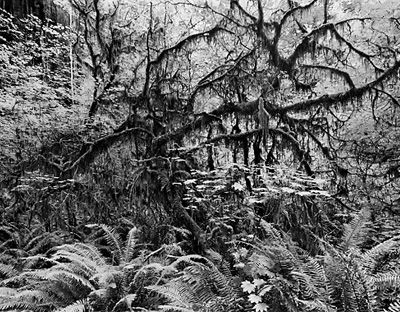
Richard Rothman


Richard Rothman began what would become his latest book in a tent in northern California, with a 4×5 camera and the intention to photograph old-growth redwood trees.
Redwood Saw, out on October 14th, is the story of Rothman’s five years photographing that forest and Crescent City, the depressed town that was cut out from it a century and a half ago. In ponderous black and white, Rothman juxtaposes the grandeur of the ancient trees with the harsh reality of a logging and fishing town that no longer has the natural resources to log or fish.
The forest photographs are arresting in their depth; Rothman consistently finds the junction at which branches, trunks, leaves, and stalks from all different plant species meet, forming a gorgeously textured tableau that speaks of the rhythms of the forest. By contrast, the images of Crescent City are divided between shots of dilapidated architecture and portraits of citizens in their homes and workplaces. The town is portrayed in a stark, almost stylized manner, as if by draining the area’s forests the logging industry managed to visibly bleed dry its own life force. If these pictures are a ruthless return to the human scale, we get some reprieve in the photos where nature and society meet. Where locals stand at the edge of the undergrowth or charred tree stumps stretch into the distance, Rothman succeeds so completely at finding a harmony and balance in the landscape that even in shots of what is undoubtedly a tragedy—a ruined forest of stumps—the regality of the natural world remains.
Click for Slideshow
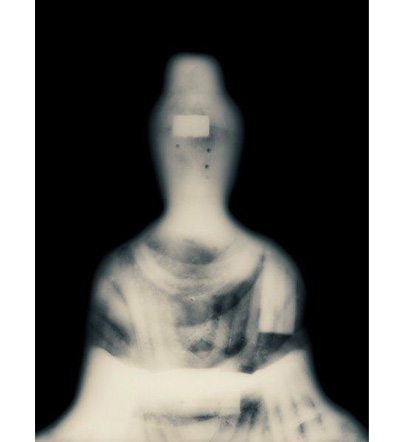
David Maisel History’s Shadow AB3, 2010

Ethereal, delicate yet raw,
David Maisel’s new book of photography,
History’s Shadow (Nazraeli Press) breathes new life into the seemingly fragile framework of ancient art. Scientific in nature – the images are actually museum conservation x-rays Maisel’s re-photographed – the undertones are pure art. Drawing from three-dimensional art objects that predate photography (courtesy of the Getty Museum, L.A. and the Asian Art Museum, San Francisco), Maisel’s photos reveal a bizarre facet of art preservation not typically displayed on a museum placard. These x-rays, intended to expose the structural well-being of valuable antiquities, have been turned on their head and transformed into some sort of meta-art for the masses.
(more…)


With the printing of On the Revolutions in 1543, Copernicus didn’t so much set the world on fire as he did set it spinning. But there were those in his time, not quite ready to receive his pioneering theories about the cosmos, who, had he lived longer, may have wished to see the astronomer himself set ablaze (à la Giordano Bruno). In her new book, A More Perfect Heaven, Dava Sobel tells of the universe-altering ideas that Copernicus put forth and the high stakes that nearly kept him from sharing his life’s work.
Breakthroughs in science ask us to imagine the unimaginable. And in 16th Century Europe, the notion of a heliocentric solar system wasn’t merely unimaginable, it was downright heretical. The conflict at the center of Sobel’s book is the decision that Copernicus had to make of whether to publish his discoveries and risk whatever reaction they might provoke. For the first time, Sobel, a science writer, also serves as playwright for a portion of the book and dramatizes the conversations that Copernicus had with Georg Joachim Rheticus, the Lutheran mathematician who ultimately convinced him to make his theories known. PLANET spoke to the author about bringing characters in scientific history to life for real this time:
(more…)
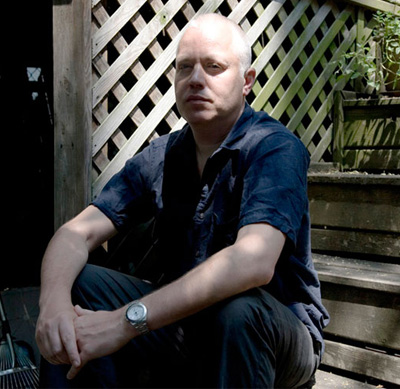
David Strettell Photography by Derek Peck


From my regular column in AnOther magazine.
David Strettell is the founder and owner of Dashwood Books, a tiny but enormously influential photography bookstore located on Bond Street in the Bowery section of Manhattan. Since opening in 2005, Dashwood has become New York City’s insider resource and social nexus for the latest in contemporary international photography. With an impressive run of book releases, signings, and talks by some of the top names in photography today, as well as pursuing its own publishing projects and being known for stocking unique titles, rare collectors’ editions, and short-run monographs of self-published work, Dashwood has come to present a broad but distinct range of today’s photographic work through the curatorial passion of one man. Previously, Strettell had assisted Mario Testino and then worked for the legendary Magnum Photo cooperative for 12 years. After leaving Magnum, Strettell says he took six months off to decide what was next for him, and chose to open Dashwood. Recently, I met with David at his East Village flat for tea, conversation, and to take a few pictures of the man behind the books.
(more…)
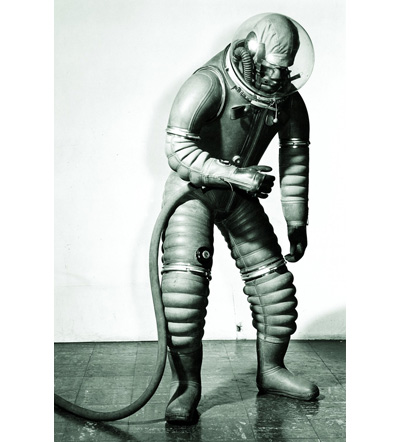
Mark 1 Tomato Worm Suit, by B. F. Goodrich.

Forty-two years after Neil Armstrong landed on the moon, the bulky, crinkly white spacesuit he wore remains an icon of the space age. While the suit was engineered by NASA to meet exacting technical standards, it was actually assembled by underwear seamstresses. This is just one intriguing aspect of spacesuit design that’s documented in the new book “Spacesuit: Fashioning Apollo,” by Nicholas de Monchaux.
When NASA first engineered the suits for the Apollo missions they wanted them to have a cold, hard, mechanical look. But the shell-like suit prototypes they produced, which made astronauts look like the Michelin Man, weren’t especially comfortable or flexible. So NASA used layers of lighter materials stitched together. The special twenty-one-layer assembly they devised had nylon inside for comfort, teflon outside for protection, and rubber-dipped fabrics in between to withstand pressure.
Click for Slideshow
(more…)
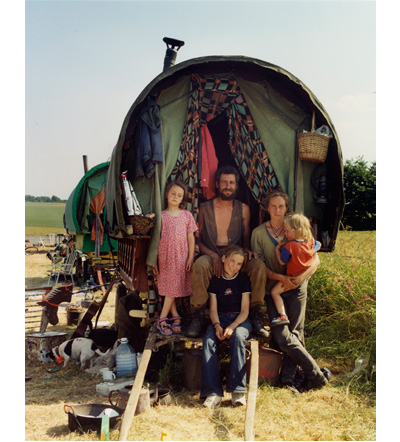

London-based fashion and social documentary photographer, Iain McKell, is notable for his arresting and unconventional images of high-fashion and youth subculture. For his recent project, The New Gypsies, McKell spent over ten years tracking and living with a small group of present-day nomads. Seeking an alternative to western capitalist society, the New Gypsies are rural anarchists. Evolving from the New Age Travellers – a group of post-punk anti-Thatcher protestors living in buses in England in the mid-80’s – the New Gypsies roam the English countryside in elaborately-decorated horse-drawn caravans, free from the reigns of urban society. Unaffiliated with the infamous ROMA gypsies residing in Central and Eastern Europe, they share no ethnographic core. Simultaneously romantic and practical, theatrical and natural, wistful and raw, McKell’s breathtaking photographs offer a first glimpse into this beautiful and subversive community. In conjunction with his current exhibit at the Clic Gallery in New York, McKell spoke with PLANET° about the origins of the project, the New Gypsies unique sense of style and visions of the future.
Click for Slideshow
(more…)
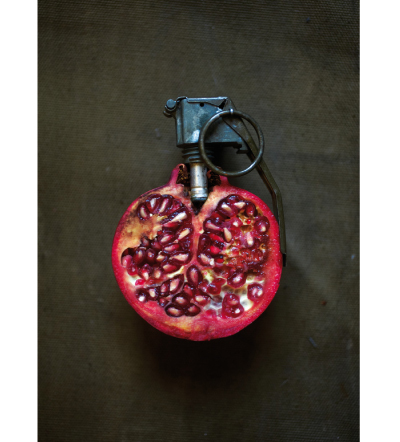
Fruit of the Boom (Granate), 2010
 Good Weather
Good Weather, an exhibit of Berlin-based artist Sarah Illenberger’s photographs at Gelstalten Space through September 11th, is an exercise in dissonance. A simple light bulb, upon a moment’s inspection, turns out to be a pear. A minimalist pair of headphones suddenly reveals itself to be made of two cupcake wrappers strung together. Straightforward in composition, lighting, and sly good nature, an Illenberger still life is lovingly handcrafted to wreak havoc on the viewer’s expectations every time. A halved pomegranate, with only a bit of metal stuck at the top, becomes an instantly recognizable hand grenade—but hasn’t the meat’s rich color, the glisten on the seeds, the plain
bloodiness of a pomegranate always spoken to your subconscious of violence? And if it didn’t, won’t it now? The joke in the photos isn’t that you’re seeing a trick object; it’s that you’re seeing two opposing images at once, and neither will yield. Illenberger spoke to PLANET about bringing her contradictions to a gallery space—right down to the name of the show.
(more…)
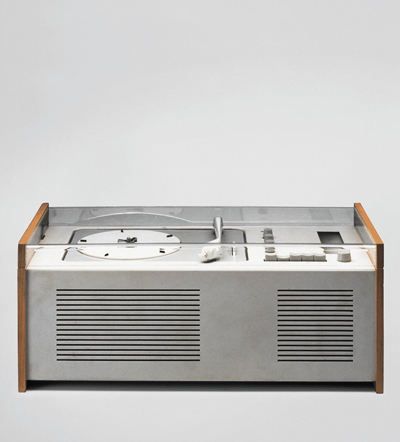
SK4 record player, designed by Dieter Rams and Hans Gugelot, courtesy of Dieter Rams.

Can you remember the first time you picked up an iPod, and how stunning it was to feel the seamlessness of its surfaces, the subtlety of its controls, and the weight of it in your hands? Those qualities, so perfect, are the work of a team of ace product designers at Apple led by Jonathan Ive. It’s no wonder then that Ive wrote the introduction to “Dieter Rams: As Little Design as Possible,” a new book about this other, legendary product designer who headed the design department at Braun from 1955 to 1980. Rams’ canonical designs for the German appliance company, Ive says, have inspired many Apple products. The transistor, alarm clocks, record players, cigarette lighters, and other small machines Rams and his team designed are seductive in their simplicity, their modernity, and their naturalism. While each is as finely-composed as an abstract sculpture there is also something, as Ive says, “inevitable” about its design. You feel as if it could not have been designed any other way.
(more…)
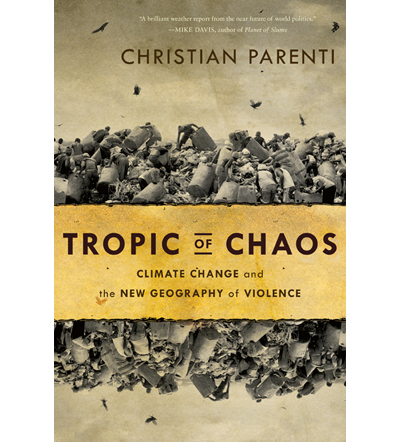
Jacket design by Ariana Abud, Jacket image from Panos Pictures

While much of the present concern over climate change has more to do with rises in temperatures and sea levels, could it be that one of the major consequences of a warming planet will end up being a rise in the occurrence of armed conflicts? That’s the scenario proposed in Tropic of Chaos, by the writer Christian Parenti. The recently published book warns convincingly of a “catastrophic convergence” in which long-term political mismanagement and instability collide with deep-seated poverty, along with the added threat of climate shocks in cases where each problem intensifies the magnitude of the next. And what’s more, the convergence is already taking place. If devastating cycles of flooding and drought weren’t reason enough to worry about our climate systems, there’s also the resulting violence that might go with them.
It’s an interesting thesis from a journalist who has spent more time covering war zones than climate zones. But as Parenti explains, his travels through the parts of the world most rife with conflict led him to observe that a common factor was contributing to the problems in each of them. He noticed that unpredictable changes in weather patterns were putting populations at risk of falling into the trap of poverty and of then fighting over the limited resources that remained. The isolated wars that he thought he was witnessing were but minor skirmishes in a greater war taking shape on a global scale.
(more…)
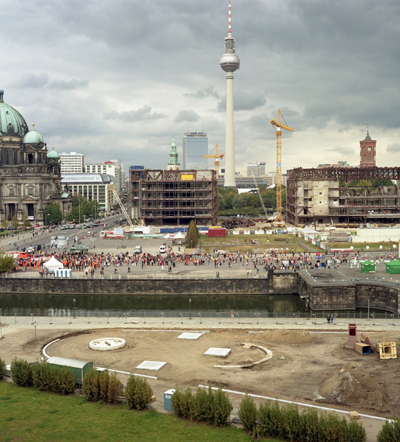
Click for slideshow Palast 2007

Just as New Yorkers are scrutinizing the development of the World Trade Center site, Berliners are scrutinizing the development of the Palast der Republik site. The Palast, an immense, East German government building completed in 1976, was condemned for asbestos in 1992 and demolished from 2006 to 2010. Located along the River Spree, amid stately nineteenth century buildings, at the very heart of Berlin’s cultural and tourist district, it had become, after the wall fell in 1989, a very visible symbol of all the wrong things: communism, oppression, censorship, and very, very bad style. A long, low concrete slab covered with gold mirrored glass, it looked like a flashy high security prison. Inside, it housed administration spaces for the city’s communist government and public spaces (lounges, bars, cafes, a bowling alley) where citizens could socialize in state-sanctioned splendor. The interiors were finished in the style of the time, with shag carpets, colored wallpaper, and chrome chandeliers studded with globe lights.
To replace the Palast the city chose to reconstruct the shell of the eighteenth century castle that previously occupied the site, which was damaged during World War II and demolished in 1950. This new castle will house a museum, a library, and shopping mall. It’s a brazen act of historical amnesia, one that looks past an unattractive chapter in history to one that’s more palatable. The project, which was suspended for financial reasons, is slated for completion in the next decade. Just last month a temporary structure, with exhibition space and a lookout point for tourists, opened at the site.
(more…)







 Facebook
Facebook Permalink
Permalink Digg
Digg Reddit
Reddit LinkedIn
LinkedIn StumbleUpon
StumbleUpon Tumblr
Tumblr











